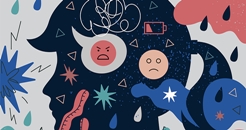 Are Adverse Childhood Experiences a public health emergency?
Are Adverse Childhood Experiences a public health emergency?
From an article by Psychology Today
Back in 1998, medical doctors Vincent Felitti and Robert Anda, found that ten adverse childhood experiences (ACEs) independently predicted a wide range of psychological and medical disorders in adulthood in a stepwise fashion. That is, the more ACEs people experienced prior to age eighteen, the more likely they were to experience poor health outcomes in adulthood.
The ten ACEs included: emotional, physical, or sexual abuse; emotional or physical neglect; or living in a home with an absent parent from divorce or separation, domestic violence, someone who was mentally ill or suicidal, someone who was addicted to alcohol, or other drugs, or someone who was incarcerated.
Since the original study was published, many other studies have confirmed the link between ACEs and health outcomes. ACEs have been found to predict:
-
Psychological conditions, such as adult depression, anxiety (including panic disorder), borderline personality disorder, drug abuse, ADHD, PTSD, suicidality, and low self-esteem
-
Medical conditions, such as obesity, autoimmune disorders (including rheumatoid arthritis, type 1 diabetes, multiple sclerosis, psoriasis, inflammatory bowel disease), fibromyalgia, chronic fatigue, nearly all sleep disorders (such as sleep apnea, insomnia, and nightmares), ulcers, Alzheimer’s disease and other forms of dementia, fractures, shortened life span, cardiovascular disease (such as heart disease and stroke), cancer, type 2 diabetes, and chronic pain
-
Risky behaviours and impaired functioning, including misusing prescription drugs (taking too much or too often, using them without a prescription, using higher numbers of prescriptions), smoking, precocious sexual activity (having multiple sex partners; teen paternity and maternity; unintended pregnancy), perpetrating and being victimized by intimate partner violence, criminality, financial or occupational challenges, memory disturbance, learning and developmental problems, more marriages, and lower educational attainment
For people who experience at least four ACEs, the risk for many health problems increases two to five times, although for drug dependency, Alzheimer’s disease, and suicide attempts, the risks are much higher. For those who experience six or more ACEs, nearly twenty years of life are lost on average.
In many high-risk populations, such as poor, urban, minority, military, and prison groups, the prevalence of ACEs often exceeds two-thirds. Felitti observed that time typically does not heal the hidden wounds from childhood and that we err to treat the smoke (that is, the stress-related conditions mentioned) without treating the fire (the unhealed hidden wounds resulting from ACEs). If the pain resulting from ACEs is not resolved, adults typically continue to suffer and fall back into harmful behaviours.
For example, Felitti found success in helping morbidly obese people lose weight. However, many of these successful weight losers rapidly regained the weight they’d lost. He found that weight served a protective purpose related to childhood wounds. For example, one might feel that extra weight made them unattractive to sexual predators. Others might find that having extra weight to throw around might protect them from bullying.
Addictions—whether they relate to alcohol, drugs, shopping, screens, anger, gambling, sex, or perfectionism—often are fueled by the need for respite from intense, unresolved inner pain.
Again, without healing the inner wounds from childhood—and associated worldviews, (such as “I’m in danger” and “I’m damaged goods”), that continue to “run their show,” individuals will continue to suffer in adulthood.
Read the full article here.
The Lancet reported in Nov 2021 "Intervening to reduce ACEs could have both substantial health and economic benefits. The authors of a systematic review estimate that, across 28 European countries, the annual economic cost of ACEs ranges from US$0·1 billion in Montenegro to $129·4 billion in Germany. In all countries, the financial cost of ACEs accounted for more than 1%, and as much as 6%, of annual GDP. However, the study also highlights a paucity of data in many countries—which is crucial to understand the distribution of ACEs and where interventions should be targeted."
Despite this knowledge, the focus of the majority of health spending in the UK is still on treating conditions once they occur rather than prevention and reduction of ACEs. Prevention starts with parenting practices and resetting social norms. Reduction starts by raising awareness in parents and also via moving to trauma-informed practices. These are being adopted by informed state agencies e.g. schools, police forces in some areas.
In the UK, there is no legislation, whereas in the USA, bills have been passed in over 20 states. This seems to be directed towards four main policy considerations:
-
Building knowledge and expertise of trauma-informed best practice
-
Building capability and capacity in services and communities for trauma-informed best practice
-
Collecting evidence of the extent of adverse childhood experiences
-
Innovating new models
See series of 4 blogs starting with Policy recommendations re ACEs - 1.
Churches in the UK can help raise awareness of ACEs in communities by signing up for The Resilience Challenge.
Retweet about this article:
From an article by Psychology Today, 21/12/2021